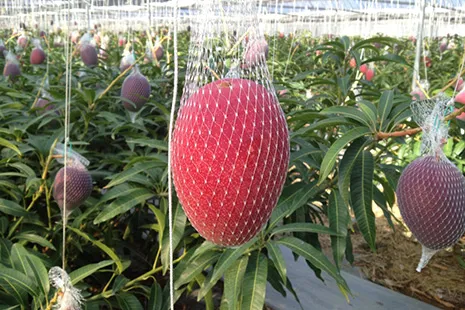The high-grade fully ripened mangoes produced in Miyazaki Prefecture are very popular as gifts in Japan and have become established as a specialty product of the region. We spoke with a staff member from JA* Miyazaki Economic Federation to learn about the origins of this widespread recognition across Japan.
Miyazaki Prefecture, located in southeastern Kyushu in the southwestern region of the Japanese archipelago, enjoys abundant sunshine throughout the year and a warm climate, fostering a flourishing agricultural sector. The prefecture boasts one of the highest shipment volumes of greenhouse-grown cucumbers and bell peppers in Japan. Miyazaki has long been celebrated for its thriving agriculture. Therefore, in order to revitalize the prefecture as a production area for even better agricultural products, agricultural producers and stakeholders have worked together under the leadership of the local governments to improve the quality of agricultural products in the prefecture. Notably, Miyazaki's fully ripened mangoes, named Taiyo-no-Tamago ("egg of the sun"), are particularly famous as luxury gifts.

We spoke with Kadouchi Hisafumi, a member of JA Miyazaki Economic Federation, to understand the history behind Miyazaki mangoes gaining recognition as a premium item. "The cultivation of mangoes in the prefecture began when a particular farmer was deeply impressed by the taste of mangoes sampled during an agricultural inspection trip to Okinawa in 1984. The following year, inspired by the experience, eight local farmers in Miyazaki gathered and started cultivating mangoes," explains Kadouchi.
The cultivation expertise was acquired from farmers in Okinawa, enabling shipments within three years. However, during that period, Miyazaki mangoes faced challenges with low recognition and inadequate quality assessment, resulting in slow sales. As farmers continued striving to stabilize mango quality, a significant discovery was made.
"Up until then, mangoes were harvested when they were about 80-90% ripe. However, it was realized that mangoes ripened on the tree had a rich sweetness, leading to an unparalleled level of flavor," comments Kadouchi. "The problem was that when mangoes reach full ripeness, they naturally fall from the tree, which can result in bruising. So, a method called 'net harvesting' was developed to catch the fruits before they fall. This innovation enabled the harvest of fully ripened mangoes, greatly advancing the branding of Miyazaki mangoes." By 1989, the quality had stabilized, and production expanded to various regions within the prefecture.
Starting from 1994, efforts were made in Miyazaki Prefecture to promote the creation of the 'Miyazaki Brand,' focusing on improving the quality and image of locally produced agricultural products. In 1998, JA Miyazaki Economic Federation launched a nickname contest, and Taiyo no Tamago was chosen for Miyazaki-grown fully ripened mangoes. In 2001, it was officially certified as Miyazaki Prefecture's brand.
Kadouchi explains, "In the JA Group Miyazaki, strict standards are set for Miyazaki-grown fully ripened mangoes. Only those mangoes that have ripened fully on the tree, fallen naturally, and met specific criteria for size, color, and sugar content are selected. Among them, only those weighing 350g or more, with a sugar content of 15 degrees or higher, and with over half of the fruit's surface covered in vibrant red coloration are certified as Taiyo no Tamago. Fruits shipped from the JA Group Miyazaki undergo full individual inspection to ensure strict quality control." The seal, individually hand-applied during inspection, serves as proof. Miyazaki-grown premium fully ripened mangoes stand as a prime example of successful collaborative branding strategy between the local governments and the farmers over more than 20 years.
"The mango shipping season is from April to July. If you visit Japan, especially Miyazaki, during this time, be sure to try these beautiful fully ripened mangoes," says Kadouchi.
Source: gov-online.go.jp
